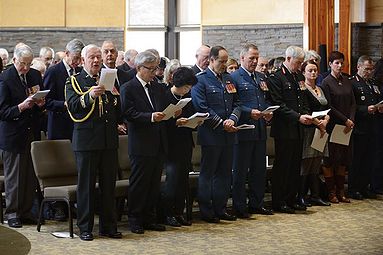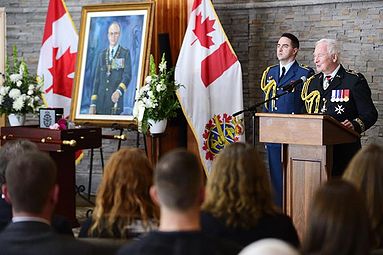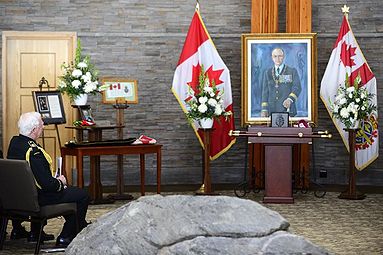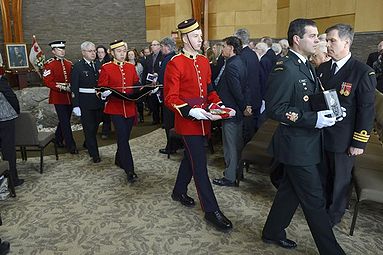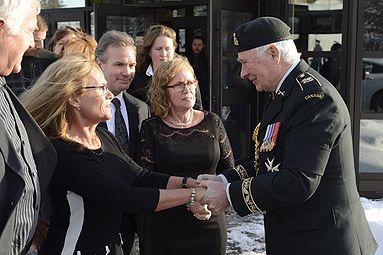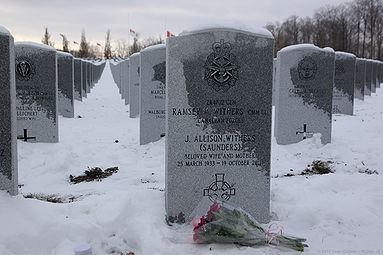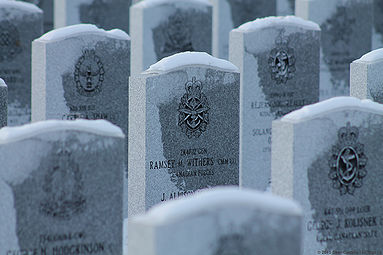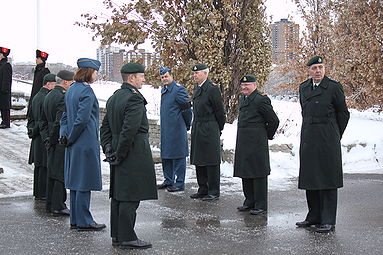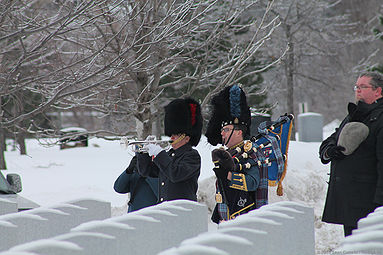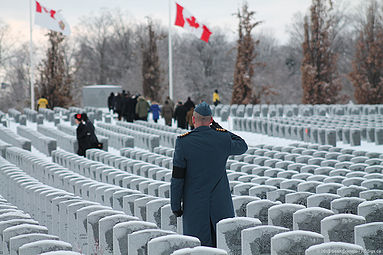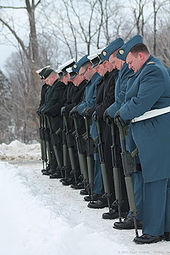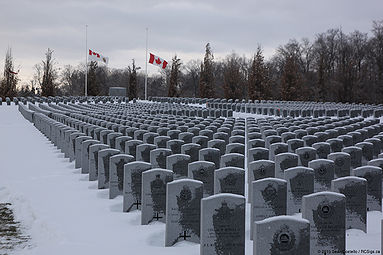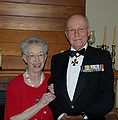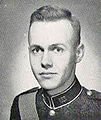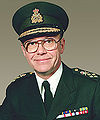Withers, Ramsey Muir
| Ramsey Muir Withers | |
|---|---|
| 28 July 1930 – 24 December 2014 | |
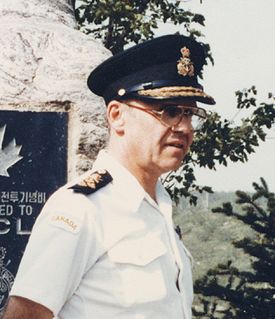 | |
| Place of birth | Scarborough Ontario |
| Place of death | Ottawa Ontairio |
| Allegiance | Canada |
| Service/branch | Canadian Army / Canadian Forces |
| Years of service | 1948 - 1983 |
| Rank | General |
| Awards | CMM, CStJ, CD, LL.D |
Contents
Early Life
Born in Scarborough, Ontario Ramsey Withers was born to Scottish immigrant parents.
Service
In 1948 he joined Canadian Service College Royal Roads and graduated from the Royal Military College of Canada (student # 2951) in 1952.[2]
Commissioned as a lieutenant with the Royal Canadian Corps of Signals, Withers served as a Signals Officer in the 1st Battalion, Royal 22e Régiment in Korea.[3] When the battalion rotated home, Withers stayed on and in late March 1953 was posted to the 1st Commonwealth Division Battle School in Japan as OC Signals Wing responsible for its communications and for the training of Infantry Signallers for Canadian, British and Australian battalions.[3][4] Returning home in August 1953, Withers went to Queen’s University to complete his electrical engineering degree graduating in 1954.
After graduation he was posted the Royal Canadian School of Signals where he served as Training Officer of 5 (Apprentice Training) Squadron for about a year and then as 2 IC 1 (Recruit and Junior NCO Training) Squadron and commanding the Jr NCO training troop. In 1956, on promotion to Captain, he became the Regimental Signal Officer of the Royal Canadian Dragoons in Petawawa and went to Germany with the Regiment in 1957.
From 1959 to 1961 he attended the first two year course at the Canadian Army Staff College where he was the top student. Upon completion, he was posted to 4 CIBG, in Soest, Germany as GSO 3 Operations. Upon promotion to Major he became the Brigade Major, essentially the Chief of Staff of the formation. From August 1963 to February 1964 he attended Course 28 at the Joint Services Staff College in England as the Canadian Army "guest" student. Having returned to Canada, he was appointed Commanding Officer of 6 Signal Squadron in Valcartier.
In the summer of 1965 Mobile Command was formed and Withers became the first Staff Officer posted to it. He was the first Command Secretary, and later, on promotion to Lieutenant-Colonel in 1966, was Senior Staff Officer Foreign Operations. He later set up the Programs Branch which planned the development of doctrine, training, equipment procurement and the like.
In August 68 he became the Executive Assistant to the CDS, first for General Allard and continuing for General Sharp when he became CDS. He was promoted Colonel in December 68 and, upon promotion to Brigadier-General in 1970, he formed Canadian Forces Northern Region, in Yellowknife where he served unti 1973.
Returning to Ottawa he had two appointments in NDHQ, first as Director General Management Information Systems until early 1975 and, on promotion to Major-General, as Associate Assistant Deputy Minister (Policy) and Chief of Evaluation. In 1976 he went back to Germany to command Canadian Forces Europe. In 1977, on promotion to Lieutenant-General, he was appointed Vice Chief of the Defence Staff. Promoted General on 31 May 1980, he was made Chief of the Defence Staff (CDS) until his retirement on 1 July 1983.[5]
Withers is a graduate of the Canadian Army Staff College and Britain's Joint Services Staff College.
Retirement Years
From his retirement as CDS in 1983 until 1988, Withers served as Deputy Minister of Transport Canada, during which time he was awarded the Commissioner's Award of the Northwest Territories and the Outstanding Achievement Award of the Public Service of Canada.[6]
After retirement, Withers became president of a government relations firm, director of an aerospace technology company, a consultant to the Office of the Auditor General and Chairman of the Industry Government Relations Group.[7]
He also continued to be active in volunteer work. In addition to chairing a committee that reviewed the undergraduate program at the Royal Military College of Canada (culminating in the Withers Report), Withers was the honorary director of the Canadian War Museum. He is a former Trustee of the Canadian Museum of Civilization and Chairman of the Canadian War Museum Committee, former Director of the Canadian Institute of Strategic Studies, and an Honorary Vice-President of the Boy Scouts of Canada.[6]
General Withers was married in 1954 to Allison (née Saunders). Together they had three children, a son and twin daughters.[5]
Honours
He was awarded the Commissioner's Award of the Northwest Territories and the Outstanding Achievement Award of the Public Service of Canada.[6] He is the winner of the Queen’s University Alumni Achievement Award. He is an honorary graduate of the National Defence College and the NATO Defense College. Withers holds two honorary doctorates.[5] Archie Cairns composed the General Ramsey M. Withers (3/4 Retreat March 2003) for bagpipes in his honour.[8]
The Memory Project
As part of The Memory Project, General Withers provided the following recollections:[3]
In August of 1952 the [25th] Canadian [Infantry] Brigade was going back into the line. And the orders had come down, I think from the corps commander, the American corps commander, that we the Canadians were to sort of imitate the 3rd US [Infantry] Division. The idea was the corps commander wanted the Chinese to think that he had rather overextended the 3rd Division, to possibly goad them into making a probing attack and taking some prisoners. So we were issued American helmets and we changed attack signs and vehicles that were going to be forward, etc. – this great deception plan. And on the air we were to use American voice procedure, which was quite different from the whole Commonwealth procedure. The Commonwealth procedure, without going into too much technical detail, was a very secure single call system, a single call sign. The American system was different. You named the station you were calling and then said who you were. For example, “Hello, Pine Pine, this is Quick Quick.” That was different from ours. Now we were supposed to do that, and, I said, “It’s not going to work very, very well for us, is it? Because we speak French.” So we were going to say “Allo, Pine Pine, voici Quick Quick. Qu’est-ce qui ce passe avant de votre position, over?” [“Hello, Pine Pine, this is Quick Quick. What is happening in front of your position, over?”] Unless you’re a battalion from Louisiana in the States, you’re not very American are you? But they insisted we do it and it gave them all of 24 hours before the Chinese put up little signs across from us, “Van Doos* welcome back.”
The signal platoon provided the signalers to the company headquarters. And generally speaking, two or three to the company headquarters to maintain communications there. Each of the platoons had its own operator who was normally also the platoon commander’s batman. So that would be – the wireless set would be carried by that individual. Sometimes on patrols the platoon commander himself would carry the backpack radio to ensure that he had immediate control to call back for fire. And then what we of course did when we had one going out like that, we had backup base sets that would be perhaps deployed at another company, or whatever, so there was always a backup. But it always radio. You didn’t carry a line out on these patrols.
Line was extremely important. I’m not going to underestimate it. Actually our main system of communication was line, telephone, for quick reaction to – in other words to call for supporting fire. Every outpost was connected by line to its company and then back to battalion. We did what was called laddering. In other words, you wouldn’t just have a single line going from a company back to the battalion, you would ladder. You would put out another line, then put it through say the neighbouring company and then back, so that you always had a bit of flexibility and redundancy.
It wasn’t very fun for us to maintain the line, because through shelling and mortaring and Chinese patrols cutting things, we were at it all the time. And of course the only time you could work in that position was at night. Because otherwise we were overviewed by the Chinese positions on the four hills including [Hill] 227 – which we called – the four hills, we called them the Apostles, Matthew, Mark, Luke and John – and they could look down on us. And so if you were out there in daylight, the line crew, you got mortared. You had to do all the work at night. And at night it was also dangerous because of possible Chinese patrols. So it was a demanding task. There was this one piece of ground between Hill 159, which was our left forward company, and leading back to battalion, where that line would be, it was being shelled out practically every day. And it was very – we were constantly repairing it until our pioneer officer Hal Merrifield had a brilliant idea. He said, “What if we take the casings off the mortar bombs coming in – they are necked down at the top – what if I blow the bottom out with explosives and then two of them will fit together. Get a bunch of those and you can bury them and put the line through that?” And we did. That line never went out again. So that was good. That was 1952.
Now I want you to cast your mind forward to 1962 and I’m now the Brigade Major of 4 Canadian [Mechanized] Brigade [Group] in Germany and I’m at a divisional conference. And I meet a British staff officer by the name of John Ballington. And you could look at his ribbons, he was in Korea. And I asked him where he was and so forth. When the ceasefire was called, he was on Hill 159. And they were given – I forget whether it was 42 or 72 hours, to take all warlike things out of what was going to be the Demilitarized Zone, and 159 was in that zone, of course. This work was overseen by these international commissioners [Military Armistice Commission] or whatever they were called, who decided whether something had to be removed or not. Well there was my little steel encrusted line and they said, “Oh that has to come out.” And John Ballington said, “We had to work almost a full day to get that damn thing out! I wish I could find the guy that put it in there!”
Art Herman was a platoon commander in the battalion. I had been at his platoon, it was on Hill 210. And that was the other thing I used to do, is go around the companies and inspect their equipment to make sure it was all working properly. And so I had a regular routine of visiting and that was the day to visit his company and I went and things were fine in his platoon. And he said, “I’ll walk up to company headquarters with you.” And I went up and we got just up to the company headquarters and I was climbing into my Jeep to go back down to battalion headquarters, when the Chinese started shelling. Art said, “Oh God. There’s three of my guys – they’re all huddled together.” And it was a Y in the trench. Art’s platoon was the last forward platoon. One branch led there and the other went to the right forward platoon and he said, “I’ll go down and disperse them. We’ll see you.” And off he went, and off I went and I got down – literally, the battalion headquarters was only about 400 metres away, and I got down there and into the command post to report in, and people were looking at me with kind of stony faces and said, “Your friend’s gone.” A 122[mm howitzer shell] came in and got Art and the other three men [on 19 August 1952].
Obituary[9]
General (Retired), CMM, CStJ, CD, LLD
July 28, 1930 - December 24, 2014
Suddenly and unexpectedly on Wednesday, December 24, 2014 in his home at The Royale in Kanata. Strong and courageous to the end, he rejoins his beloved wife, Jean Alison Saunders (d. 2011), but leaves a grieving family. The son of William Withers (d. 1952) and Alice Hannah (d. 1989), he was born in York Township on July 28, 1930. His brother Scott Withers is deceased. He will be greatly missed by his children James Withers (Caroline), Leslie Gray (Paul), Deidre Brown (John), his grandchildren Rebecca and Iaian, Samantha and Erik, Lauren and Kristen, Justine and Laine, and Paul, Emily and Erin, and his great- grandchildren, Ramsey Cecil and Makenna Elizabeth Alison. General Withers' long career as a soldier and civil servant was marked by deep integrity and professional excellence. A decorated Korean War veteran, General Withers began his service at HMCS Royal Roads (H2951, Honorary President – RMC Club) in 1948. As an officer of the Royal Canadian Corps of Signals, General Withers served with both the Royal 22e Régiment and the Royal Canadian Dragoons. General Withers held senior appointments in Yellowknife, Germany and Ottawa, culminating with his appointment as Chief of the Defence Staff. After retiring, he also served as Honorary Lieutenant-Colonel of the Governor-General's Foot Guards. In 1983, General Withers was appointed Deputy Minister of Transport, and later worked in the private sector. He also dedicated much of his time to volunteering, particularly with the Canadian Museum of Civilization, the Canadian War Museum and Scouts Canada. General Withers will be missed and fondly remembered by his friends at the Royale in Kanata, and by the other members of the Canadian War Museum's "A Team", with whom he served as a volunteer interpreter even up to the week of his passing. Family and friends are invited to visit at Beechwood, Funeral, Cemetery and Cremation Services, 280 Beechwood Avenue, Ottawa on January 9, 2015 from 1700 - 2100hrs, and on January 10, 2015 from 1100hrs until time of a Memorial Service at 1300 hrs. Interment to follow in the National Military Cemetery of Beechwood. In memoriam donations should be to the Canadian War Museum, the Military Families Fund, the Salvation Army or a charity of your choice.
Celebration of Life
General Withers was interred following a celebration of life at The National Military Cemetery of the Canadian Forces on 10 January, 2015.
Related Pages
Related Items
References
- ↑ With material from Wikipedia
- ↑ http://www.friends-amis.org/bio_withers_e.html
- ↑ 3.0 3.1 3.2 The Memory Project - Ramsey Muir Withers
- ↑ http://everitas.rmcclub.ca/?p=13116
- ↑ 5.0 5.1 5.2 Biography - General Ramsey M. Withers (dead link)
- ↑ 6.0 6.1 6.2 Canadian Encyclopedia - Ramsey Muir Withers
- ↑ General (retd.) Ramsey Withers - FCWM Director (dead link)
- ↑ Major Archie Cairns, M.M.M., C.D. 'Pipe Music Book 2' General Ramsey M. Withers (3/4 Retreat March 2003)
- ↑ http://www.legacy.com/obituaries/ottawacitizen/obituary.aspx?pid=173675890
.
